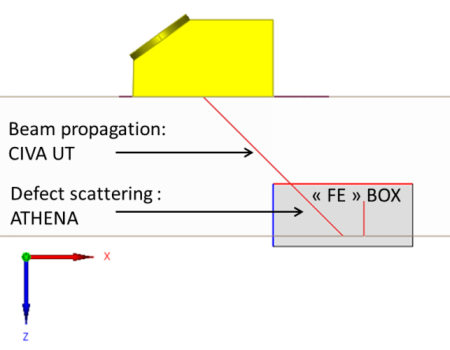This new CIVA module is the result of a coupling between CIVA UT and ATHENA2D’s Finite Element Method (FEM), developed by EDF. ATHENA2D has been integrated into CIVA by the CEA in order to extend the Non Destructive Testing UT simulation possibilities in CIVA.
 CIVA ATHENA 2D Finite Element rectangular box
CIVA ATHENA 2D Finite Element rectangular box
Thanks to this combination, while doing a simulation it is now possible to take into account all the physical phenomena regarding the beam/defect interactions, even the most complex, within a perimeter defined by the user and placed around the defects. This interface remains close to the usual CIVA interface and does not require knowledge of FEM.
In CIVA ATHENA2D, a finite element rectangular box is defined. Outside of this box, the UT beam propagation is modelled with the conventional semi-analytical method of CIVA (pencil method). In the box, the calculation is made by FEM (using the incident beam, calculated on the box boundaries as an input). Typically, FEM will be used to simulate UT beam/defect interactions (and beam/geometry interactions) whereas the fast semi-analytic model is used to simulate the round trip propagation of ultrasound from the transducer.
Doing it this way, the computation is faster than a complete finite element computation, while all phenomena are accounted for regarding the beam/defect interactions.
The configuration is defined in the user-friendly CIVA interface, with very few specific parameters. Thus, CIVA ATHENA 2D is easy to use.
The results from this new module are the classical curves and images available in CIVA UT (A-scans, B-scans, 3D view, reconstructed view, etc.), but CIVA ATHENA 2D can give additional snapshots of the field/flaw interactions, providing a better understanding. It is even possible to create a video file, showing the propagation of the beam and its interactions in the FEM zone.
What are the advantages of this new tool?
It will recognize all the phenomena, even the most complex, with a faster calculation time than a solely FEM based approach.
You can also visualize the beam propagation and its interaction with flaws.
For more information about this new module, visit EXTENDE’s webpage on http://www.extende.com/civa-2/civa-athena-2d.